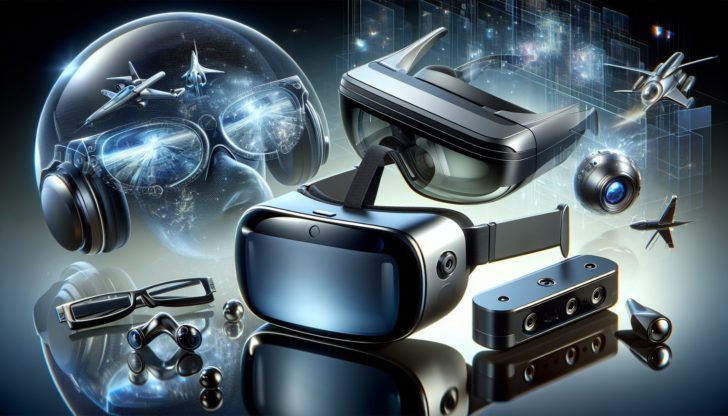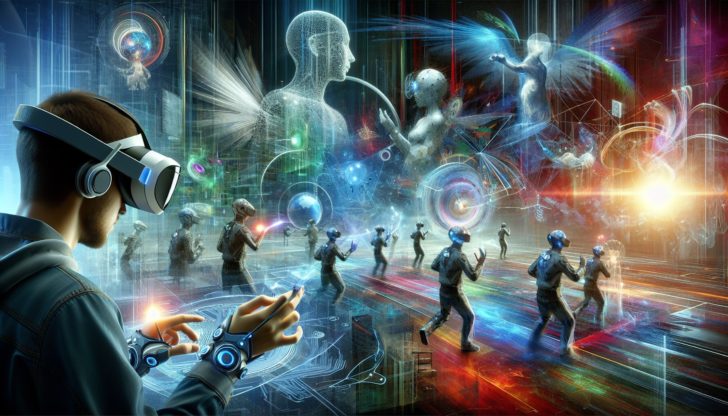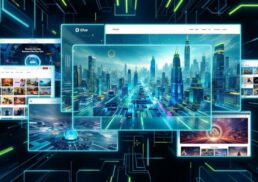Imagine a world where physical and digital realities are indistinguishable. This is the essence of extended reality (XR), a technological frontier that’s already transforming how we live, learn, and play. As you navigate this guide, you’ll uncover how XR is currently applied and how it will continue to evolve, revolutionizing every facet of modern life.
Table of Contents
Key Takeaways
Extended Reality (XR) merges physical and digital worlds through Virtual Reality (VR), Augmented Reality (AR), and Mixed Reality (MR), revolutionizing interactions and experiences in diverse sectors such as training, education, and entertainment.
Advancements in XR hardware and software, such as novel devices like VR headsets and AR glasses and improved real-time rendering technologies, drive the evolution of immersive, interactive virtual environments.
XR is being actively implemented across various industries, notably in education for enhanced learning, healthcare for improved training and patient care, and entertainment for immersive experiences, underscoring its transformative impact.
Unveiling Extended Reality (XR)

Extended Reality (XR), a term that represents an array of immersive technologies, is no longer a concept of the future but an integral part of our present. The components of XR, including Virtual Reality (VR), Augmented Reality (AR), and Mixed Reality (MR), are shaping an era where virtual worlds blend seamlessly with our reality, paving the way for unprecedented experiences.
These immersive technologies aim to revolutionize interactivity and perception across various applications such as:
training
education
entertainment
collaboration
By intertwining our physical world with digital overlays, XR is set to redefine the boundaries of our experiences in the digital environment.
Defining XR
When we speak of XR, we are referring to a spectrum of immersive experiences that merge the physical and digital worlds. At one end of this spectrum is VR, where users can transport into an entirely virtual environment disconnected from their physical surroundings, simply by wearing a VR headset. These fully immersive vr experiences allow users to explore digital worlds like never before.
At the other end of the spectrum lies AR, where digital elements are overlaid onto our real world, enhancing our perception of reality. MR, on the other hand, combines elements of both AR and VR to create a seamless environment where physical and digital objects co-exist and interact in real-time.
These technologies, collectively referred to as XR, are shaping a future where the line between the physical and the virtual becomes increasingly blurred.
XR Devices and Experiences
The canvas of XR is painted using a variety of devices including VR headsets, AR glasses, and MR headsets, each offering unique experiences. For instance, don a VR headset and you can find yourself exploring the ruins of an ancient civilization, or walking on the moon. Hold up your AR-enabled smartphone and watch as a life-sized dinosaur appears in your living room. With an MR headset, you could manipulate holographic models in your physical space as if they were real objects.
These experiences are not confined to the realm of imagination anymore; they are becoming increasingly integral to our daily lives. From gaming and entertainment to education and training, these XR devices are revolutionizing the way we interact with the digital world, offering customized experiences that were hitherto unthinkable.
The Role of AI in XR
The evolution of XR is not a lone journey. It’s accompanied by another powerful force – Artificial Intelligence (AI). AI has a significant role to play in enhancing the interactive and intelligent capabilities of XR environments, making these experiences more immersive and intuitive.
For instance, in VR, AI can serve as a virtual assistant to designers, providing support and facilitation in the creative process. In the case of AR, AI can present intelligent overlays that guide users through various processes, such as assembling a piece of furniture. The integration of AI into XR is not merely transformative; it promises to rewrite the rulebook on how we interact with and within virtual spaces.
Learn more, visit Extended Reality: Exploring the Future of Immersive Technologies.
The Evolution of Virtual Worlds
The journey of XR and virtual worlds is an exciting narrative of vision, innovation, and evolution. It was in the 1980s that the concept of Virtual Reality was popularized, with the term itself coined in 1987 by Jaron Lanier, whose work heavily contributed to the field. Initial public experiences of VR, such as the Sensorama and the Sword of Damocles, were not only novel but also laid the foundation for future VR technologies.
Over the years, advancements in computer technology and software development have greatly increased the complexity and realism of VR environments. Breakthroughs in VR hardware and input devices have provided users with significantly enhanced immersive experiences and intuitive controls. Today, VR and XR technologies are not merely limited to entertainment but have found impactful applications in sectors like education, healthcare, and military, indicating the maturation of XR from a conceptual to a functional technology.
From Novelty to Necessity
Diving deeper into the timeline of XR, we see its transition from being a novelty to a necessity. Prior to the consumer launch of high-profile VR systems like HTC Vive and Oculus Rift, extended reality technologies were largely inaccessible, primarily utilized by large institutions and academic researchers due to high costs. The advent of these VR systems brought XR to the masses, opening a world filled with unlimited possibilities.
Today, XR has moved beyond being a novelty or an intriguing concept. It has become a necessity in various industries, revolutionizing workflows, enhancing productivity, and providing immersive experiences that enhance user engagement.
Breakthroughs in XR Hardware
The growth and evolution of XR has been fueled in large part by breakthroughs in hardware technologies. The launch of Apple’s first Mixed Reality headset, the Apple VisionPro, for instance, is anticipated to significantly impact consumer and enterprise markets with its advanced features and applications.
In addition to individual products, broader trends in the XR industry are also shaping the future of this technology. The term ‘Spatial Computing’, for example, has gained popularity and is considered a new paradigm in computing, with industry leaders like Apple, Meta, Microsoft, AWS, and Magic Leap highlighting its importance.
The increasing diversity in the Smartglass market, with companies announcing ultra-light consumer Smartglasses like the XReal Air 2, indicates the continuous innovation and evolution in XR hardware.
Software Innovations
As pivotal as the hardware breakthroughs have been, the magic of XR lies in the software that powers these experiences. Real-time rendering technologies have significantly improved, enabling the creation of highly detailed and lifelike virtual environments. These advancements are essential for simulations in XR, as they allow dynamic changes to environments in response to user interactions.
The sophistication of interactive elements, such as object manipulation and environmental effects, have also seen a leap, contributing to immersive XR experiences. This innovation in software has made it possible to develop complex virtual environments that can be altered in real-time by users’ actions, opening the door to limitless possibilities for immersion and interactivity.
XR in Action: Industry Use Cases

The transformative potential of XR is no longer a theory; it’s a reality being played out across diverse industries. From the federal domain to the automotive design industry, early adopters of VR, a component of XR, have demonstrated the wide-ranging applications of these immersive technologies.
The incorporation of XR in various sectors has led to enhanced design processes, improved training methods, and more in-depth data analysis. The impact of XR on these industries is a testament to its capability to foster innovation and efficiency, showcasing the potential for future applications and advancements.
XR in Education
The transformative power of XR technology can be seen in its impact on education. Mixed reality (MR) enhances learning by allowing learners to immerse themselves in a full 360° visual experience. With MR technology, learners can engage in a variety of interactive activities, enhancing their educational journey.
MR enables a blended learning environment where students can interact with both physical and digital objects in real-time, facilitating a hands-on approach to learning. This is just one example of how XR is revolutionizing education, providing experiences that stimulate engagement and enhance learning outcomes.
XR in Healthcare
The healthcare sector is another industry where XR is making a transformative impact. For instance, VR training in healthcare allows medical professionals to develop skills in a safe environment. Through these training programs, learners can encounter true-to-life scenarios without facing real-world risks.
The use of XR in healthcare extends beyond training. From surgical simulations to therapeutic applications, XR is contributing to enhanced patient care, streamlined medical procedures, and improved outcomes.
XR in Entertainment
Perhaps the most visible impact of XR is in the realm of entertainment. Extended reality technologies, particularly Virtual Reality (VR), are revolutionizing the entertainment industry by providing deeply immersive experiences that were not possible with traditional mediums.
Whether it’s theme parks incorporating VR to create attractions where physical rides are enhanced with virtual scenarios, or virtual concerts that allow fans to experience live performances in a digital space, XR is taking entertainment to a whole new level.
In gaming, XR technologies have paved the way for interactive experiences that react to user input, enabling real time responses and creating dynamic and adaptive gaming environments.
Designing for XR: A Creator’s Perspective
To truly appreciate the magic of XR, it’s important to understand the creative process that goes into designing these immersive experiences. Unity is an example of a platform used by students to develop XR applications, illustrating its importance in the XR development process.
Designing for XR is no small feat. It involves:
Crafting immersive environments
Ensuring seamless interaction and user experience
Overcoming design challenges to create experiences that are not just visually stunning but also functional and user-friendly.
Crafting Immersive Environments
Creating immersive XR environments is a complex process that requires a blend of creativity, technical expertise, and a deep understanding of user behavior. For instance, programs like the Bachelor of Science in Extended Reality prepare students for developing immersive VR experiences, writing efficient code, and conducting quality assurance testing.
With the advent of platforms such as NVIDIA Omniverse, the creation of 3D simulations, virtual worlds, and virtual objects has been revolutionized, enabling global collaboration and operation of digital twin simulations. These tools and platforms provide the canvas for developers to paint their XR masterpieces, creating immersive experiences that engage and captivate users.
Interaction and User Experience
Interaction design is at the heart of any XR experience. Understanding user interaction in XR requires comprehending the unique spatial computing aspects that differentiate it from traditional 2D interfaces. The aim is to blend physical and digital elements in a way which feels natural and intuitive to the user.
User experience design for XR focuses on:
Minimizing physical discomfort, such as motion sickness, by optimizing interface elements and user movements
Employing user-centered design principles in XR to craft experiences that are accessible and accommodating to diverse user needs
Ensuring an enjoyable and immersive XR journey for all users
Overcoming Design Challenges
The path of designing for XR is not without its challenges. Developers often face technological limitations that can hinder the creation of immersive experiences, such as limited processing power and the need for high-resolution graphics.
However, these challenges also serve as catalysts for innovation. To mitigate technological constraints like latency, XR developers employ methods such as asynchronous time warp and space warp, which help maintain fluid motion and prevent motion sickness.
By focusing on usability and accessibility, developers can enhance user experiences, ensuring that the magic of XR is available to an increasingly diverse audience.
The Future Landscape of XR Technology

As we stand on the brink of a new era in XR technology, it’s fascinating to imagine what the future holds. The roadmap for XR is filled with exciting possibilities, including:
Enhanced photorealism
Spatial audio
Nuanced haptic feedback
Integration of AI
Quantum computing
These advancements will shape the future of XR and open up new possibilities for immersive experiences.
These advancements are not just about improving the quality of the virtual worlds we inhabit; they are about transforming the way we interact, learn, work, and play. They showcase the potential of XR to facilitate remote work and collaboration across global distances, effectively reducing barriers to international business.
XR and the Networked World
The advent of 5G networks and edge computing is set to significantly impact the future of XR experiences. By significantly reducing latency, 5G networks will enhance real-time interactivity in XR applications. Furthermore, the high bandwidth of 5G allows for more complex and data-intensive XR experiences, supporting higher-resolution graphics and larger user capacities.
Edge computing, on the other hand, will play a critical role in handling the data processing demands of XR, enabling quicker responses and reducing latency further. As we move into a more connected world, the synergy between XR, 5G networks, and edge computing is set to redefine our digital experiences.
Machine Learning Meets XR
Machine learning is another powerful ally in the evolution of XR. By enabling dynamic content adaptation in response to user behavior, machine learning enhances user experiences in XR through data exploration.
The integration of machine learning with XR can lead to:
Adaptive environments that respond intelligently to user behavior
Personalizing the XR environment in real-time
Anticipating user needs and presenting relevant content
Machine learning is set to make XR experiences smarter, more intuitive, and highly personalized as devices create customized experiences.
Visionary XR Solutions
Looking ahead, the future of XR is teeming with visionary solutions that could revolutionize the way we interact with virtual worlds. Imagine an XR experience that enables hyper-realistic haptic feedback systems to simulate texture, pressure, and temperature, or one that simulates complex scents and environmental conditions.
Innovative user interfaces are on the horizon for XR, including:
Mind-controlled inputs that bypass traditional physical interactions
Advances in AI and predictive algorithms that could lead to XR experiences that anticipate user needs and respond to unspoken prompts
The integration of quantum computing with XR that could lead to breakthroughs in processing power, enabling highly complex simulations of reality.
Summary
In conclusion, Extended Reality (XR) is not just a technological revolution; it’s the dawn of a new reality that intertwines the physical and digital worlds in unprecedented ways. As we’ve seen, XR is transforming various industries, revolutionizing workflows, and enhancing user experiences. The future of XR promises a world of hyper-realistic, interactive, and personalized experiences, enabled by breakthroughs in hardware, software, AI, and machine learning. As we stand on the brink of this new era, we can’t help but be excited about the limitless possibilities that XR holds for us.
Frequently Asked Questions
What is Extended Reality (XR)?
Extended Reality (XR) is a term encompassing Virtual Reality (VR), Augmented Reality (AR), and Mixed Reality (MR), all of which are immersive technologies.
How is XR being used in education?
XR is revolutionizing education, allowing learners to have immersive and interactive experiences that facilitate a hands-on approach to learning.
What are some of the challenges in designing for XR?
Designing for XR presents challenges including technological limitations like processing power and high-resolution graphics, as well as the need to optimize user experience for minimal discomfort and maximum accessibility.
How is machine learning enhancing XR experiences?
Machine learning enhances XR experiences by dynamically adapting content based on user behavior, personalizing the environment and anticipating user needs in real-time. This provides a unique and tailored experience.
What are some future advancements expected in XR technology?
Future advancements in XR technology are expected to include enhanced photorealism, improvements in spatial audio, nuanced haptic feedback, integration of AI and quantum computing, and the development of visionary XR solutions such as mind-controlled inputs and hyper-realistic haptic feedback systems. Exciting things are on the horizon.









